
Picture this: you're strolling through a vast, untamed landscape, the sun casting a warm glow on the rolling hills before you. Suddenly, a peculiar sight catches your eye – a group of emus, their long necks stretched high as they roam freely amidst the wilderness.
But what if I told you that these enigmatic creatures hold a key to the very survival of their habitat? Emus, though seemingly ordinary, play a vital role in the delicate balance of ecosystems.
In fact, their decline in numbers poses a significant threat to biodiversity. So, why should you care about the preservation of emus?
Well, my friend, the answers lie in the intricate web of life that these flightless birds are woven into.
Key Takeaways
- Emus are keystone species that have a profound impact on the overall structure and function of their ecosystems.
- The decline in emu populations can have negative effects on biodiversity, including reduced seed dispersal, altered habitat structure, and changes in predator-prey dynamics.
- Conservation efforts are being made to protect emus and their habitats, including the preservation of protected areas and addressing habitat loss caused by human activities.
- Emus provide important ecosystem services, such as seed dispersal, habitat restoration, and control of insect and small animal populations.
The Role of Emus in Ecosystems
Emus play a vital role in ecosystems as key contributors to biodiversity preservation. These fascinating flightless birds aren't only iconic symbols of the Australian outback but also important players in maintaining the delicate balance of nature. Emus are considered keystone species, meaning their presence or absence greatly impacts the overall structure and function of their ecosystems.
One of the primary roles of emus in ecosystems is their position in food chains. As herbivores, they consume a variety of plant matter, including grasses, fruits, and seeds. By doing so, emus help control plant populations, preventing overgrowth and ensuring the availability of resources for other animals. Additionally, emus aid in seed dispersal through their feces, allowing for the colonization of new areas and the expansion of plant species diversity.
Furthermore, emus contribute to the ecological balance of their habitats. Their foraging behavior helps shape vegetation structure, creating diverse habitats for other organisms. Emus' selective feeding habits can also influence plant composition, promoting the growth of certain species over others and influencing the overall biodiversity of the ecosystem.
Emus as Keystone Species
Keystone species, such as emus, play a crucial role in maintaining the balance and functioning of ecosystems through their significant impacts on biodiversity. Emus aren't only fascinating creatures but also hold immense importance in preserving the delicate equilibrium of their habitats.
Here are five reasons why emus are considered keystone species in ecosystems:
- Seed dispersal: Emus consume various fruits and seeds, aiding in their dispersal across the landscape. As they move and defecate, they help plants colonize new areas, promoting plant diversity.
- Vegetation control: Emus have a voracious appetite for vegetation, particularly grasses. By grazing on certain plants, they prevent them from dominating the ecosystem, allowing other plant species to thrive.
- Nutrient cycling: Emus' feeding habits contribute to nutrient cycling. Their droppings act as natural fertilizers, enriching the soil and supporting the growth of diverse plant species.
- Ecosystem engineers: Emus, through their foraging behavior, can modify their environment. By trampling vegetation or digging for food, they create microhabitats for smaller organisms, enhancing overall biodiversity.
- Predator control: Emus are known to consume small vertebrates and invertebrates, including insects. By regulating the population of these prey species, they indirectly impact the entire food web, preventing overpopulation.
As keystone species, emus exert a profound influence on their ecosystems, and their preservation is vital for maintaining the health and diversity of these intricate natural systems.
Threats to Emu Populations

Threats to the population of emus, a keystone species in many ecosystems, pose significant challenges to their survival and the biodiversity they support. Overhunting and habitat loss are two major factors contributing to the decline in emu populations.
Overhunting has had a detrimental impact on emu populations in many regions. Emus were historically hunted for their meat, feathers, and eggs. However, uncontrolled hunting practices have led to the depletion of emu populations. The demand for emu products, such as oil and leather, has further intensified the hunting pressure. This has resulted in a decline in emu numbers, disrupting the delicate balance of ecosystems in which they play a crucial role.
Habitat loss is another significant threat to emu populations. As human activities expand, natural habitats are being cleared for agriculture, urban development, and infrastructure. Emus require large, open spaces to forage, breed, and raise their young. With their habitats increasingly fragmented or destroyed, emus face challenges in finding suitable areas for survival. This loss of habitat not only affects emus directly but also impacts other species that depend on emus for food and habitat.
To ensure the survival of emus and the biodiversity they support, it's vital to address the threats of overhunting and habitat loss. Implementing sustainable hunting practices and preserving and restoring their natural habitats are essential steps in safeguarding these remarkable birds and the ecosystems they inhabit.
Impacts of Emu Decline on Biodiversity
The decline in emu populations has had significant repercussions on the biodiversity of the ecosystems they inhabit. Emus, as keystone species, play a crucial role in maintaining the delicate balance of their ecosystems. Their decline has led to a cascade of impacts, affecting various aspects of biodiversity. Here are some of the key impacts:
- Loss of seed dispersal: Emus are efficient seed dispersers, as their diet includes a variety of fruits and seeds. With their decline, the dispersal of seeds has been greatly reduced, affecting the establishment and survival of plant species.
- Altered vegetation structure: Emus feed on shrubs and grasses, helping to maintain a balanced vegetation structure. Their decline has resulted in an overgrowth of certain plant species, leading to changes in habitat structure and reduced habitat suitability for other organisms.
- Reduced insect control: Emus consume large quantities of insects, acting as natural pest controllers. With their decline, insect populations may increase, potentially causing imbalances in the ecosystem and affecting the abundance of other species.
- Loss of food source: Emus are prey for various predators, including dingoes and foxes. The decline in emu populations can disrupt the food chain, impacting the predators that depend on emus as a food source.
- Decreased nutrient cycling: Emus play a role in nutrient cycling by depositing feces that enrich the soil. Their decline can lead to a reduction in nutrient availability, affecting the growth and development of plants and other organisms.
Understanding the impacts of emu decline on biodiversity is crucial for developing conservation strategies to mitigate these effects and preserve the delicate balance of ecosystems. By addressing the decline in emu populations, we can protect not only this iconic species but also the rich biodiversity that depends on their presence.
Conservation Efforts for Emus

To address the decline in emu populations and promote their conservation, various efforts are being implemented to protect and restore their habitats.
Emus are highly dependent on their natural habitats, and the effects of habitat loss have been detrimental to their numbers. Loss of suitable habitats, due to factors such as urbanization, agricultural expansion, and land degradation, has resulted in a significant decline in emu populations.
In response, conservation organizations and government agencies have initiated efforts to safeguard emus and their habitats.
One crucial conservation strategy is the establishment of protected areas. These areas serve as sanctuaries for emus, ensuring the preservation of their habitats and providing a safe space for breeding and foraging activities.
Additionally, habitat restoration programs are being implemented to reverse the effects of habitat loss. These programs involve initiatives such as reforestation, wetland restoration, and the removal of invasive species that threaten emu habitats.
Another important conservation effort is the implementation of reintroduction programs. These programs aim to reintroduce emus into areas where they've become locally extinct due to habitat loss or hunting. Through careful planning and monitoring, emus can be successfully reintroduced, helping to restore their populations and reestablish their ecological roles.
Benefits of Preserving Emus
Preserving emus contributes to the maintenance of ecosystem balance and biodiversity. These magnificent birds play a crucial role in the environment, providing numerous benefits that are both economically valuable and culturally significant.
Here are some of the key benefits of preserving emus:
- Economic value: Emus have significant economic value as they contribute to the tourism industry. People from all over the world visit emu farms and sanctuaries to learn about these unique creatures and engage in ecotourism activities. This boosts local economies and creates job opportunities in rural areas.
- Cultural significance: Emus hold great cultural significance for indigenous communities. They're often featured in traditional stories, art, and ceremonies. Preserving emus helps to maintain cultural heritage and promote cultural diversity.
- Seed dispersal: Emus play a vital role in seed dispersal. As they consume a variety of fruits and plants, their droppings spread seeds across different areas, helping to regenerate vegetation and maintain plant diversity.
- Ecosystem balance: Emus are considered keystone species, meaning their presence or absence significantly affects the entire ecosystem. They control the population of insects and small animals, preventing overpopulation and maintaining a balanced ecosystem.
- Pollination: Emus are known to be important pollinators, especially for native plants. By spreading pollen from flower to flower, they facilitate plant reproduction, ensuring the survival of many plant species.
Preserving emus not only benefits the environment but also enriches local economies and preserves cultural heritage. By recognizing their value and protecting their habitats, we can ensure a sustainable future for both emus and the ecosystems they inhabit.
Emus and Biodiversity Conservation

Emus play a crucial role in biodiversity conservation due to their unique ecological interactions and contributions to ecosystem stability. These large flightless birds are not only fascinating creatures but also provide important ecosystem services that promote habitat restoration and support the overall health of ecosystems.
One of the key ways emus contribute to biodiversity conservation is through their role as seed dispersers. Emus consume a wide variety of fruits and seeds, and their digestive system is able to break down tough seed coatings. This allows them to effectively disperse seeds across different habitats, aiding in the colonization and regeneration of vegetation.
Additionally, emus are known to create disturbances in the soil through their foraging behavior. This disturbance helps to break up compacted soils, increase nutrient availability, and promote plant diversity. By creating patches of disturbed soil, emus create microhabitats that support the growth of different plant species, enhancing overall biodiversity.
Furthermore, emus' grazing activities can also influence vegetation structure and composition, leading to changes in habitat structure that benefit a variety of wildlife species.
In summary, emus play a vital role in biodiversity conservation through their interactions with the environment. Their ability to disperse seeds, create disturbances in the soil, and influence vegetation structure makes them important contributors to ecosystem stability and habitat restoration. By understanding and appreciating the ecological importance of emus, we can better prioritize their conservation and ensure the preservation of biodiversity for future generations.
| Emus and Ecosystem Services | Emus and Habitat Restoration | Emus and Biodiversity Conservation |
|---|---|---|
| Seed dispersers | Soil disturbers | Contributors to ecosystem stability |
| Enhance vegetation growth | Promote plant diversity | Support habitat restoration |
| Influence habitat structure | Create microhabitats | Promote overall biodiversity |
Frequently Asked Questions
Do Emus Have Any Natural Predators in Their Ecosystems?
Emus do have natural predators in their ecosystems. These predators play a crucial role in maintaining the balance of the ecosystem by controlling the population of emus and preventing their overgrowth.
How Do Emus Contribute to the Overall Balance and Stability of Their Ecosystems?
Emus, as keystone species, play a vital role in maintaining the overall balance and stability of their ecosystems. Their foraging habits help control vegetation growth, which in turn affects the presence of other species. Emus contribute to ecosystem resilience.
Are There Any Specific Threats or Challenges That Emus Face in Modern Times?
In modern times, emus face various challenges and threats to their survival. These include habitat loss due to human activities, predation by introduced species, and the impact of climate change on their ecosystems.
What Are Some Specific Examples of How the Decline in Emu Populations Can Negatively Impact Biodiversity?
When emu populations decline, it can have a negative impact on biodiversity. Emus play a vital role in ecosystem balance by dispersing seeds, controlling vegetation, and providing food for other species.
What Are Some Ongoing Conservation Efforts That Are Being Undertaken to Protect Emus and Their Habitats?
Conservation efforts are crucial for protecting emus and their habitats. Ongoing initiatives focus on habitat protection, including the establishment of protected areas, restoration of degraded habitats, and community involvement in conservation activities.
Conclusion
In conclusion, it's clear that the preservation of emus is crucial for maintaining biodiversity. As keystone species, emus play a vital role in ecosystems by dispersing seeds and controlling vegetation.
However, their populations are facing threats, which could have detrimental impacts on biodiversity. By implementing conservation efforts and preserving emus, we can ensure the continued balance and health of our ecosystems.
So, ask yourself, can we afford to lose such a valuable species and risk the consequences for biodiversity?




